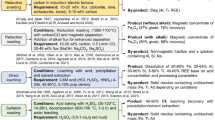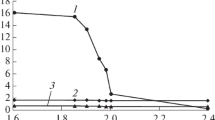The amounts of large-tonnage mineral waste that are generated raise serious misgivings at environmental protection agencies. Most mineral waste is a valuable secondary raw material, but the lack of integrated technologies for their processing substantially slows down their processing. An assessment was made of the possibility of joint processing of quartz-leucoxene concentrate (waste from oil extraction) and brucite-containing waste from the production of refractories. Joint pyrometallurgical processing of two wastes made it possible to obtain magnesium titanate, a valuable product for different industries. In hydrometallurgical processing of magnesium titanate, a complex magnesium-titanium containing coagulant was obtained, which showed high efficiency in the process of treating high-pH wastewater (concrete mixing unit). In addition to increasing the purification efficiency (reducing the residual concentrations of pollutants), the use of a complex reagent made it possible to reduce reagent costs and intensify the sedimentation and filtration of coagulation sludge (simplification of the instrumentation).


Similar content being viewed by others
References
V. A. Panfilov, E. E. Melchakov, and P. I. Chernyshev, “ATM-1: discovery in water purification and water treatment,” Ecology of Production, No. 10(147), 68 – 70 (2016).
E. A. Agapova, and P. I. Chernyshev, “Purification of water from heavy metal ions using refractories production waste,” in: Report 12th Intern. Scientific-Pract. Conf. for Students, Graduate Students and Young Scientists, Gubkin, 18 Apr. 2019 [in Russian], Gubkin (2019), pp. 4 – 5.
G. R. Bochkarev, G. I. Pushkareva, and K. A. Kovalenko, “Sorption purification of aqueous media from arsenic using natural and modified brucite,” Izv. Vysh. Uchebn. Zaved., Stroit-vo, No. 6, 59 – 64 (2011).
G. I. Pushkareva, “Influence of heat treatment of brucite on its sorption properties,” Fiz.-Tekhn. Prob. Razrab. Polez. Iskop., No. 2. 102 – 108 (2010).
L. Z. Bykhovskiy, L. I. Remizova, and O. S. Chebotareva, “Ore base of titanium in Russia: development and development potential,” Chernaya Metall., Byull. Nauch.-Tekh. Ekon. Inform., No. 10, 16 – 22 (2017).
D. Yu. Kopyev, K. G. Anisonyan, T. V. Olyunina, and G. B. Sadikhov, “Influence of the conditions for reducing roasting of leucoxene concentrate on its opening during sulfuric acid decomposition,” Tsvetn. Met., No. 11, 56 – 61 (2018). DOI: https://doi.org/10.17580/tsm.2018.11.08
K. G. Anisonyan, G. B. Sadikhov, T. V. Olyunina, et al., “Investigation of the process of magnetizing roasting of leucoxene concentrate,” Metally, No. 4, 62 – 66 (2011).
Yu. V. Zablotskaya, G. B. Sadikhov, T. V. Olyunina, and T. V. Goncharenko, “Prospects for the development of the Yaregskoye deposit as a source of obtaining artificial rutile and wollastonite,” Chernaya Metall., Byull. Nauch.-Tekh. Ekon. Inform., No. 9, 12 – 15 (2015).
G. B. Sadykhov, Yu. V. Zablotskaya, K. G. Anisonyan, et al., “Extraction of high-quality titanium raw materials from leucoxene concentrates of the Yarega deposit,” Russian Metallurgy (Metally), No. 11, 1015 – 1019 (2018). DOI: https://doi.org/10.1134/s0036029518110101
I. A. Perovskiy, I. N. Burtsev, A. V. Ponaryadov, and A. A. Smorokov, “Ammonium fluoride roasting and water leaching of leucoxene concentrates to produce a high-grade titanium dioxide resource (of the Yaregskoye deposit, Timan, Russia),” Russian Metallurgiya (Metally), 210(105858) (2022). URL: https://doi.org/10.1016/j.hydromet.2022.105858
A. A. Smorokov, A. S. Kantaev, D. V. Bryankin, and A. A. Miklashevich, “Development of a method for low-temperature desiliconization of the leucoxene concentrate of the Yaregskoe deposit by means of a solution of ammonium hydrofluoride,” Izv. Vysh. Uchebn. Zaved., Khim. Khim. Tekhnol., 65(2), 127 – 133 (2022). DOI: https://doi.org/10.6060/ivkkt.20226502.6551.
A. A. Nikolaev, D. E. Kirpichev, and A. V. Nikolaev, “Thermophysical parameters of the anode region of plasma arc under the reduction smelting of quartz-leucoxene concentrate in a metal-graphite reactor,” Inorg. Mater. Appl. Res., 11, 563 – 567 (2020). DOI: https://doi.org/10.1134/S207511332003034X.
E. I. Istomina, P. V. Istomin, A. V. Nadutkin, and V. E. Grass, “Desiliconization of leucoxene concentrate on vacuum silico-thermal treatment,” No. 3, 5 – 9 (2020). DOI: https://doi.org/10.17073/1683-4518-2020-3-5-9
K. L. Zanaveskin, S. M. Zanaveskina, A. N. Maslennikov, et al., “Activation of quartz-leucoxene concentrate for processing into titanium tetrachloride,” Russian J. Appl. Chem., 89(11), 1733 – 1739 (2016). DOI: https://doi.org/10.1134/S107042721611001X
K. L. Zanaveskin, A. N. Maslennikov, S.M. Zanaveskina, et al., “Leaching SiO2 and Al2O3 impurities from leucoxene of the Yaregskoe deposit by means of a sodium hydroxide solution,” Theor. Found. Chem. Eng., 53(4), 669 – 679 (2019). DOI: https://doi.org/10.1134/S0040579519040110.
E. N. Kuzin, N. E. Kruchinina, A. B. Fadeev, and T. I. Nosova, “Principles of pyro-hydrometallurgical processing of quartz-leucoxene concentrate with the formation of pseudo-brookite phase,” Obogashch. Rud, No. 3, 33 – 38 (2021). DOI: https://doi.org/10.17580/or.2021.03.06.
E. N. Kuzin, I. G. Mokrushin, and N. E. Kruchinina, “Principles of pyrometallurgical processing of quartz-leucoxene concentrate with the formation of a pseudo-brookite phase, Part 2. Phase transformations,” Obogashch. Rud, No. 5, 23 – 28 (2022). DOI: https://doi.org/10.17580/or.2022.05.04
M. M. T. Zin, D. Tiwari, and D. J. Kim, “Maximizing ammonium and phosphate recovery from food wastewater and incinerated sewage sludge ash by optimal Mg dose with RSM,” J. Industr. Eng. Chem., 6, 136 – 143 (2020). DOI: https://doi.org/10.1016/j.jiec.2020.02.020
H. Xu, P. He,W. Gu, et al., “Recovery of phosphorus as struvite from sewage sludge ash,” J. Environ. Sci., 24(8), 1533 – 1541 (2012). DOI: https://doi.org/10.1016/s1001-0742(11)60969-8
E. Sh. Gayazova, I. G. Shaikhiev, I. P. Grigorieva, and C. B. Fridland, “Investigation of magnesium sulfate for wastewater treatment of rapeseed pulp production,” Vest. Kazan. Tekhnol. Univ., No. 9, 159 – 161 (2012).
Y. Gan, J. Li, L. Zhang, et al., “Potential of titanium coagulants for water and wastewater treatment: Current status and future perspectives,” Chem. Eng. J., 406(126837) (2021). DOI: https://doi.org/10.1016/j.cej.2020.126837
M. Thomas, J. B1k, and J. Królikowska, “Efficiency of titanium salts as alternative coagulants in water and wastewater treatment: Short review,” Desalination Water Treat., 208, 261 – 272 (2020). DOI: https://doi.org/10.5004/dwt.2020.26689
E. N. Kuzin, “Application of atomic emission spectroscopy with microwave (magnetic) plasma in identifying the chemical compositions of steelmaking waste,” Chernye Metally, No. 10, 79 – 82 (2022). DOI: https://doi.org/10.17580/chm.2022.10.13.
L. Borkovska, L. Khomenkova, T. Stara, et al., “Optical and structural properties of Mn-doped magnesium titanates fabricated with excess MgO,” Mater. Today Commun., 27(102373) (2021). DOI: https://doi.org/10.1016/j.mtcomm.2021.102373
Y. Suzuki and Y. Shinoda, “Magnesium dititanate (MgTi2O5) with pseudobrookite structure: a review,” Sci. Technol. Adv. Mater., 12(3), 034301 (2011). DOI: https://doi.org/10.1088/1468-6996/12/3/034301
S. Maitra, R. Mitra, and T. K. Nath, “Aqueous Mg-ion supercapacitor and Bi-functional electrocatalyst based on MgTiO2 nanoparticles,” J. Nanosci. Nanotechnol., 21(12), 6217 – 6226 (2021). DOI: https://doi.org/10.1166/jnn.2021.19321
Ya. G. Goroshchenko, Titanium Chemistry [in Russian], Nauk. Dumka, Kiev (1970).
E. N. Kuzin, N. E. Kruchinina, P. S. Gromovykh, and Ya. V. Tyaglova “Coagulants in the processes of waste water treatment in dairy complex industry,” Chem. Sustainable Devel., 28, 388 – 393 (2020).
E. Kuzin, Y. Averina, A. Kurbatov, et al., “Titanium-containing coagulants in wastewater treatment processes in the alcohol industry,” Processes, 10(3), 440 – 449 (2022).
Author information
Authors and Affiliations
Corresponding author
Additional information
Translated from Steklo i Keramika, No. 7, pp. 43 – 49, July, 2023.
Rights and permissions
Springer Nature or its licensor (e.g. a society or other partner) holds exclusive rights to this article under a publishing agreement with the author(s) or other rightsholder(s); author self-archiving of the accepted manuscript version of this article is solely governed by the terms of such publishing agreement and applicable law.
About this article
Cite this article
Kuzin, E.N. Joint Processing of Quartz-Leucoxene Concentrate and Brucite-Containing Waste from the Manufacture of Refractory Materials with the Preparation of Complex Coagulants. Glass Ceram 80, 295–299 (2023). https://doi.org/10.1007/s10717-023-00601-w
Received:
Published:
Issue Date:
DOI: https://doi.org/10.1007/s10717-023-00601-w




